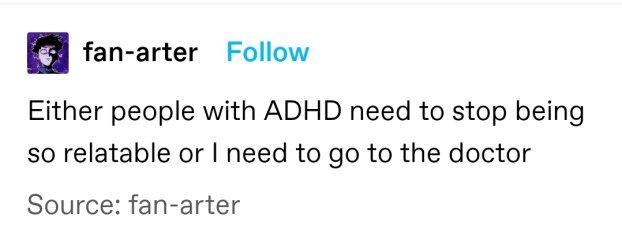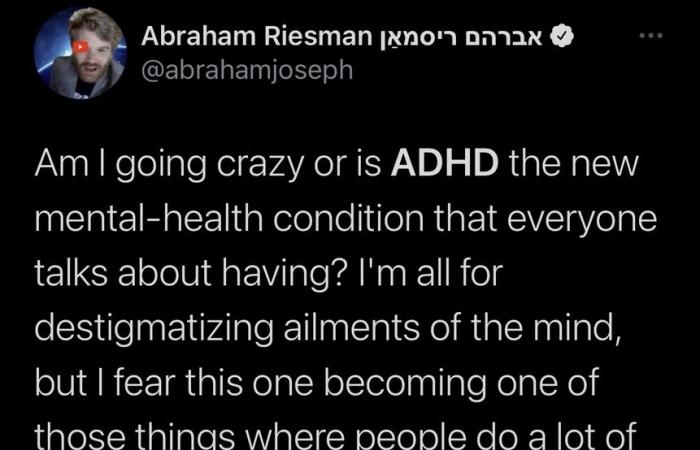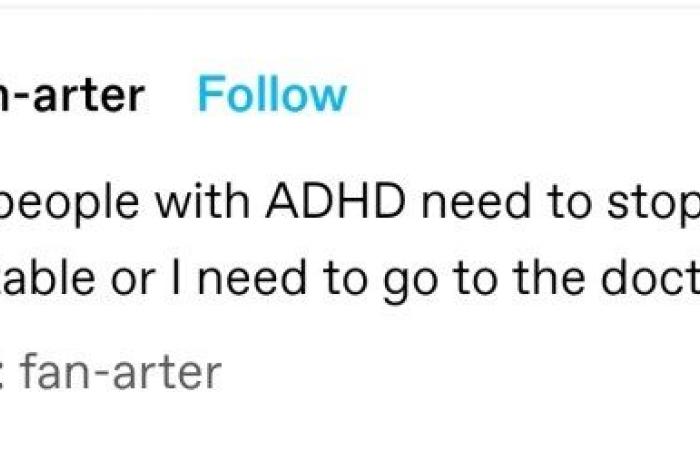October is ADHD Awareness Month. Attention Deficit / Hyperactivity Disorder (ADHD) affects roughly 4.4% of adults in the United States that is about 16.5 million people. The number is probably higher than there are Sad Underdiagnosis of women and people of color with the disorder. Now that the month is almost over, thinking about what better could have been done to lessen the stigma surrounding disability is a worthwhile endeavor.
During this month, many of those making an effort to educate the public about ADHD inadvertently simplified the disorder. Vague tweets describe a symptom that can be traced back to a range of disorders or health problems, and this has led to waves of people on social media believing they have ADHD.
It is always positive for people who have not been diagnosed to receive confirmation of a problem that is weighing on their life. However, these online representations paint a false narrative that ADHD is “assignable”. Traits that can be attributed to people with depression, anxiety, obsessive-compulsive disorder, autism, bipolar disorder, PTSD, and many different learning disorders are used solely to indicate ADHD.
In reality, ADHD is complicated and really debilitating. I may like parts of my ADHD as it adds to my creativity. It gives me the opportunity to focus on what I enjoy and it allows me to think in ways the average non-ADHD person would never understand. But there are other aspects of the disorder that make me wish my mind were neurotypical.
Neurotypical refers to a person who does not have ADHD, autism, and / or other neurological disorders that act in a similar way. Someone with one or more of these disorders would be referred to as neurodivers or neurodivergent. A concept called Neurodiversity believes that these disorders are part of a normal and natural variation in the human genome, not the result of disease or injury. This is an antithesis to people who are performing who are actively seeking a “cure” for Autism or ADHD when we really need help, adjustment and understanding.
Neurodiversity simply sums up these neurological differences– –different, but not inherently bad or deficient. There is evidence that these conditions existed way back in human history. It is even theorized that ADHD played an evolutionary role for the benefit of those who lived a nomadic hunter-gatherer lifestyle instead of a stationary agricultural life. Neurodiversity is a way for people with disorder to recognize both their advantages and disadvantages.
People tend to think of ADHD only in terms of attention span and hyperactivity. This is understandable as both are included in the name of the disorder. However, this is not the full range of his symptoms. People with ADHD are unable to regulate their emotions right. You may be overly irritated by something mundane but uncomfortable and the feeling will go away as soon as it comes. This also leads to the fact that emotions are under-experienced, e.g. For example, feeling deaf and unable to cry at a close relative’s funeral.
Some believe that ADHD actually doesn’t exist and is designed to be used as a prescription for stimulants for children. Or they believe it is overdiagnosed because “all children are hyperactive and have attention problems”. This perpetuates harmful stigmatizations and stereotypes, and teaches children to be ashamed of their need to take stimulants in order to focus. ADHD was confirmed Again and again, to be a real disorder, we nonetheless have to deal with people who deny the reality of our condition. Stimulants have been proven Influence people with ADHD differently than the rest of the population, which leaves us calm and focused rather than overwhelmed. But no matter how many studies are done, there is always someone trying claim our disorder is false.
Perhaps the most disadvantageous belief in teaching young people with ADHD is that their tendency to hesitate or have difficulty getting things done is akin to laziness. However, this is far from the truth. Laziness involves an active decision not to do something that is easy to do. With ADHD, you can spend days trying to get something done, but no matter how hard your efforts are, you still can’t get it done. You may not be able to concentrate. Sometimes you suffer from management dysfunction and cannot change roles. In other cases, stress is so overwhelming that the thought of opening a book or laptop causes panic. You lose track of time due to Time blindness and discover that it is 5 p.m. and you haven’t eaten, dressed, or changed since 8 a.m.
I have the primarily inattentive type of ADHD (ADHD-PI) and wasn’t officially diagnosed until I was 20 years old. I was able to get along in elementary and middle school without teachers reporting me as a child to be screened for a learning disorder. I was relatively calm, afraid of authority, had no major behavioral problems, and was an voracious reader. But I would dream all the time and lose focus in class. I would use books as a way out if I found a topic boring. I would make silly mistakes on homework and exams because I read something too quickly or because I wasn’t paying close attention. As I went through school, it became more and more mentally strenuous to force myself to concentrate. I would come home and lie in a dark room for hours until my brain recharged.
The interests for which I could get attention were largely academic, so I was labeled “Too High To Fight”. An administrator in high school told my parents verbatim this when I was trying to get extra time for tests. This denial of 504 accommodations for students with disabilities is against the law, but unfortunately a common occurrence.
When I got to college, the increased workload made it harder to identify my symptoms. Years of undiagnosed have put me at a disadvantage. Untreated ADHD in children can lead to one Increase in severity of symptoms as a teenager and an adult. It leads to high occurrences of depression and anxiety disorders in adolescent and adolescent girls. I am constantly trying to compensate for the lost years in which I should have learned the right skills and coping mechanisms for my disorder. I have to play an infinite game of catching up to get to a place where I can manage school, life, work and everything else without breaking down every two weeks.
Some of these feelings can be traced back to physical differences in the structure, development, and function of the brain. On average there are people with ADHD three years back in brain development compared to their neurotypical counterparts, and certain structures of the brain such as the frontal lobes are smaller than average. A decrease in the neurotransmitters for dopamine and norepinephrine leads to decreased brain activity. This can lead people with ADHD to seek out activities with immediate or short-term rewards to increase dopamine, which outwardly can manifest as impulsiveness or risk taking.
ADHD is not the assignable disorder that many refer to it as. ADHD is a disability and it has debilitating effects on people’s lives. The misconception that ADHD is not real or that people are overdiagnosed is extremely harmful. It perpetuates stigma and stereotypes that make people like me fly under the radar and go undiagnosed for years. As this month comes to an end, reconsider how you feel about ADHD and the people with ADHD. Neither of us benefits from being classified as one of two extremes.


ADHD isn’t just the hyperactive kid who keeps getting into trouble. ADHD is the girl who is calm and prone to daydreaming. The child who gets good grades but still makes mistakes. The one who tries his best, but it’s not enough. The teenager whose outbursts and mood swings are due to poor parenting. The 25 year old who is still struggling to get into college. The 40 year old who feels like he has never been able to bring his life together. We are real people with real struggles. We deserve our stories to be heard, and not told, by those who believe they know all about our disorder.
These were the details of the news For ADHD Awareness Month, it’s time to change how we think... for this day. We hope that we have succeeded by giving you the full details and information. To follow all our news, you can subscribe to the alerts system or to one of our different systems to provide you with all that is new.
It is also worth noting that the original news has been published and is available at de24.news and the editorial team at AlKhaleej Today has confirmed it and it has been modified, and it may have been completely transferred or quoted from it and you can read and follow this news from its main source.


